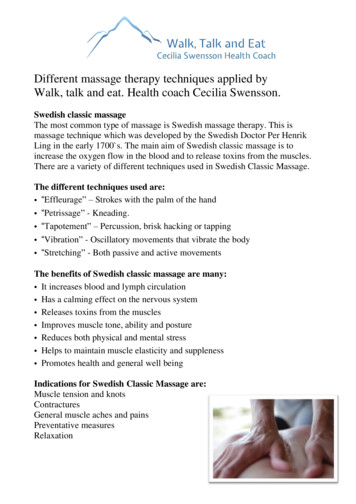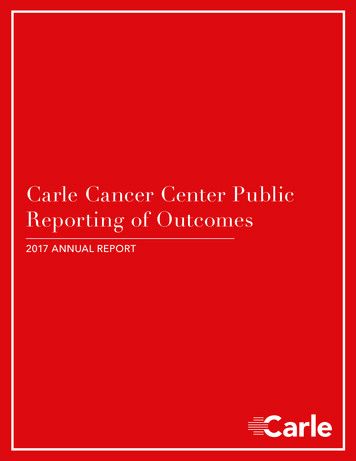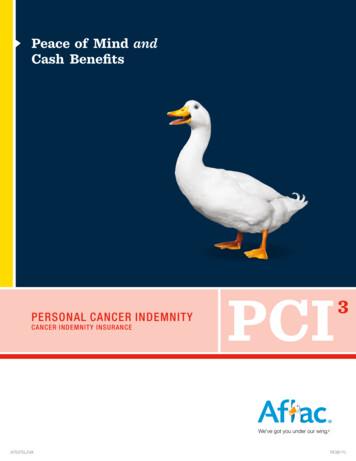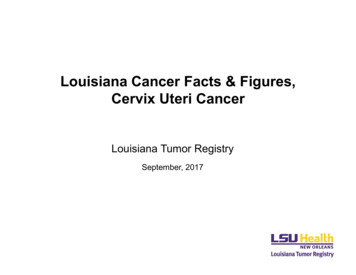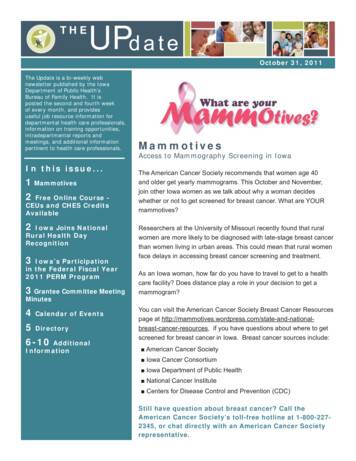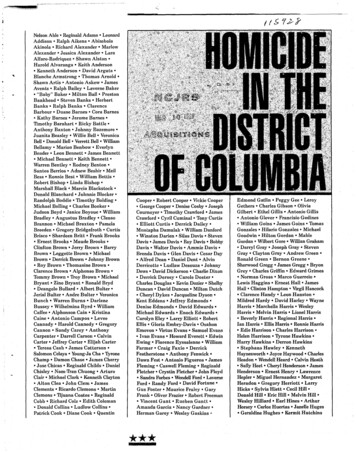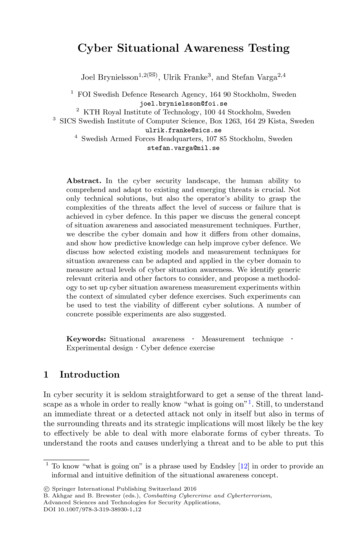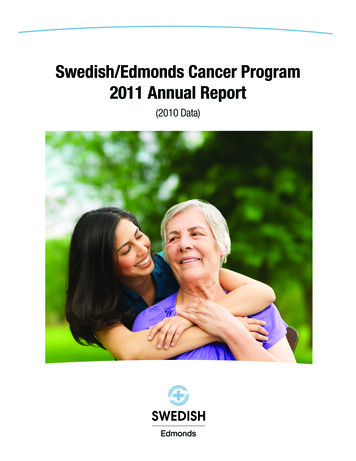
Transcription
Swedish/Edmonds Cancer Program2011 Annual Report(2010 Data)
Cancer Committee Members 2011Eileen Johnston, M.D.Oncology/HematologyCancer Committee ChairJason Schneier, M.D.GastroenterologyRoger Shelton, M.D.GynecologyRobert Takamiya, M.D.Radiation OncologyCancer Liaison PhysicianSally Browning, M.D.Radiology – Breast CenterDaniel Markowitz, M.D.Oncology/HematologyAlan Boudousquie, M.D.PathologyJeffery Ward, M.D.Oncology/HematologyCarol Cornejo, M.D.General SurgeryErnest Kawamoto, M.D.PathologyJudy Cody, BSN, CTRTumor RegistryKeith Luther, M.D.Internal MedicineDarlene Hetrick, R.N.Clinical Manager, SurgicalOncologyJohn Maldazys, M.D.UrologyTawnia Kemp, CTRTumor RegistryJon Olson, M.D.Pain Management–2–Susanne KrombergSpiritual Care Manager – StaffChaplainHeather Lingbloom, RHIAHIM Dept. Operations ManagerPam Martino, RHITQuality ManagementJulie Norman, RD, CD, CDENutritional ServicesMaxine Riordan, MSWSocial ServicesJerri WoodQuality of Life ManagerAmerican Cancer SocietyNancy Wood, R.N.Chief Nurse Executive
Chairman’s Report 2011Eileen Johnston, M.D.Oncology/HematologyCancer Committee ChairmanCancer care at Swedish/Edmonds is evolving rightbe enhanced in the inpatient and outpatient settings. Itbefore your eyes. As I enter my third year as chairmanis anticipated that billing accuracy and timeliness willof the Cancer Control Committee for Swedish/Edmondsalso benefit.I am surrounded every day by positive changes thatcontinually improve the experiences of our patientsAnother clinical improvement this year has been thewith cancer. Like the rest of the country, we are func-addition of the da Vinci Surgical System.This surgicaltioning in the world of health care as an industry withrobot is utilized primarily for gynecologic and urologicall of the economic, political and emotional upheavalprocedures such as nephrectomy, cystectomy and hys-that an industry of such importance engenders. In orderterectomy, but has other potential uses as well. Studiesto protect our vision and commitment to health-carehave shown that use of a daVinci robot can shortenexcellence we have had to adapt quickly; as they say,hospital stays and is associated with less blood loss, less“keep up or get out of the way.”pain and fewer surgical complications. Our surgeonsare thrilled to be able to offer our patients this state-of-Our affiliation with Swedish Health Services in Sep-the-art surgical technique.tember 2010 has provided us with valuable resources(intellectual, financial and visionary) to aid us on thisUnder the auspices of the Campaign for Swedish, thenever-ending quest. The affiliation allows us to cutSwedish/Edmonds Gala took place this past November.waste and provide a leaner, more efficient health-careOver 500 people attended including many physicians,system. Of course, an affiliation brings change andadministrators, patients and concerned communitychange can sometimes bring angst for patients, provid-members. Together, we raised more than 420,000ers and staff. As a medical community we have workedfor the future of our medical community. This vote ofhard to focus on the positives of change and to help theconfidence and sign of optimism is extremely movingcommunity we serve do the same.for those of us who provide care at this campus. Weknow we have expectations to fulfill and are pleased toThis year Swedish/Edmonds will implement Epic,continue to meet them.a fully electronic medical record and billing softwaresystem. This will enhance accessibility of patient recordsPerhaps the most visible upcoming change is thefor the treating clinicians who in emergent medical situ-construction of our new comprehensive cancer centerations often don’t have time to wait for the arrival ofon the Swedish/Edmonds campus in 2013. This fully-paper charts. Inter-physician communication will alsomodern facility will be two stories and will house our–3–
medical oncologists, medical oncology chemotherapyA major change has been the expansion of the roleinfusion center and a fully equipped oncology phar-of cancer liaison physician whose job is myriad, butmacy.includes a great deal of community interaction. I amhappy to announce that Robert Takamiya, M.D. of ourTreating clinicians have been involved in every step ofradiation oncology division has graciously acceptedplanning, we are confident that there will be dramaticthis challenging role. You can read his perspective in animprovements to patient care from arrival to departure.accompanying article. A major focus in upcoming yearsWe anticipate that this beautiful new center will open inwill be the development of “survivorship plans” whichthe first half of 2013.will summarize diagnosis, treatments received, toxicitiesSome changes are externally driven. Our cancer pro-encountered, long-term follow-up plans and expecta-gram is accredited by The Commission on Cancer andtions for our patients.in turn overseen by the American College of Surgeons.Accreditation is not easily obtained as standards areI hope it is clear that this medical community is for-high. Our program undergoes an extensive on-siteward thinking, ambitious, compassionate and absolute-review process every three years while less formally committed to the provision of superior cancer care.reviews are conducted continuously via Internet. OurWe have to wear many hats every day to make theselast on-site review was in October, 2010 and we passedvisions a reality, but the trust and faith our patients andwith flying colors. However, updated standards haveour community place in us keep us motivated. We arejust been implemented for this and coming years. Theseall pleased and excited by the growth and success of ourstandards are rigorous and continually help drive usprogram over the last several years.toward more comprehensive services related to cancer.A rendering of the new two-story cancer center at Swedish/Edmonds. Rendering courtesy Perkins Will.–4–
Cancer Liaison ReportRobert Takamiya, M.D.Radiation OncologyCancer Committee MemberI am honored to be named the Cancer Liaison Physi-I look forward to my new role and the challengescian (CLP) of Swedish/Edmonds. The CLP is a physi-ahead. I am enthusiastic about enacting new programscian member of the Cancer Control Committee whothrough our cancer program at Swedish/Edmonds toacts as a liaison for the Commission on Cancer (CoC)improve the quality of care for our patients and com-to implement changes within the cancer committee. Themunity.CLP’s goals are to improve quality of care, promoteadvocacy, and to partner with the American CancerSociety (ACS). In addition, we strive to improve patientoutcomes through clinical trial enrollment and use ofproper staging and treatment guidelines.The CLP role underwent significant change at thesummit meeting in 2009. Clarification and expansion ofkey areas were provided. It defined the following newgoals for 2012: Monitoring and interpreting facilities perfor-mance using the National Cancer Database (NCDB)and reporting tools Analyze and report NCDB data for presenta-tion to the cancer committee Work within the cancer committee to improvequality of care based on NCDB data Collaborate with the data registrar and ensureaccurate reporting of institutional data to the NCDB Present reports to the cancer committee Lead efforts, initiatives and studies to improvequality and process of cancer care in the facility Report CoC activities, initiatives and prioritiesto the cancer committee Serve as a physician representative to ACS–5–
Swedish Cancer Institute at Swedish/EdmondsSwedish Cancer Institute at Swedish/Edmonds re-and close cooperation with our medical oncology col-mains committed to delivering the highest quality treat-leagues, surgeons and other specialists at Swedish/Ed-ment using state-of-the-art equipment in a patient-cen-monds, we continue to offer the most up-to-date multi-tered care environment. Fully one-third of our patientsdisciplinary treatment approaches to our patients. Ourreceive treatment with intensity-modulated radiationalliance with Swedish Cancer Institute, Seattle Prostatetherapy (IMRT), a technique which improves accuracy,Institute, and the Tumor Institute Radiation Oncologyminimizes toxicity, and increases radiation dose, therebyGroup allows us to offer all modern radiation oncologyimproving cure rates.services. This includes Gamma Knife and Cyberkniferadiosurgery, high dose rate brachytherapy for gyne-We offer the most advanced form of IMRT calledcologic and urologic malignancies, systemic radiationimage-guided radiation therapy (IGRT). Implantedtherapy, external beam radiation therapy (IMRT-IGRT)fiducial markers allow visualization of the target areaand the premier radioactive seed implantation pro-with each treatment, which in turn allows for smallergram in the United States. Due to our technology andtreatment fields and fewer side effects than standardexpertise, residents and fellows from the top trainingIMRT. We continue to offer samarium and strontiumprograms in the country regularly travel to Seattle totherapy, an intravenous targeted radionuclide used forobserve these therapies.palliation of painful bone metastases. We also offerradioactive monoclonal antibody therapy in appropriate patients with lymphoma. Comprehensive services,including physics and dosimetry support, radiationoncology nursing, radiation therapists, social services,and nutritional counseling, are available to provideindividualized and compassionate care to patients andtheir families.We have a robust prostate brachytherapy program atSwedish/Edmonds. Utilizing the new urology operatingsuite, we have all-new high-end equipment. Prostatebrachytherapy is the implantation of radioactive seedsto cure prostate cancer with a high degree of precisionutilizing ultrasound guidance. Long-term data confirmscure rates equivalent to surgery, but without many ofthe surgery-related morbidities. Our association withthe Seattle Prostate Institute was instrumental in building this program and offering it to our community.Through participation in the weekly Tumor Board–6–
Puget Sound Cancer CentersPuget Sound Cancer Centers (PSCC), Edmonds, is acancer center, adjacent to our current facility, scheduledvibrant, state-of-the-art medical oncology practice onto open in the first half of 2013. This two-story, 16,000the grounds of the Swedish/Edmonds campus. Our fivesquare foot building will be ready for occupancy thisphysicians are all board certified and their experiencesummer and promises ongoing quality care in an en-with cancer care ranges from 18 to over 30 years. Ourhanced environment, emphasizing patient comfort andphysicians are committed to providing superior care insystematic efficiency.a personalized setting. To facilitate this goal we havebuilt a strong staff of nurses, medical assistants andThe quality of our program is endorsed by our Com-support staff. Our nurses maintain the highest levelmission on Cancer certification (with commendation)of chemotherapy administration certification (OCN).and our Quality Observation Performance InstituteThe remainder of our staff is continuously trained to(QOPI) certification (an award granted to fewer thanhelp our patients navigate the increasingly complicated20 percent of cancer programs nationally). Despiteworlds of insurance coverage and health systems. Wethese external accolades, we measure our success by theare proud to say that our staff is intuitively empathic,patients we treat. Our outcomes consistently comparekind and generous. Our patients effusively speak of thefavorably with national norms and our patients con-nurturing environment they find at PSCC.tinue to refer loved ones for care. We remain grateful tothe community and to our referring providers for thePSCC offers a full range of cancer care includingtrust and confidence they place in PSCC each day. Wechemotherapy, immunotherapy, radioimmunotherapy,promise to do all we can to continue to deserve thatbiologic therapy and supportive care. An extensivetrust.array of clinical trials is available to our patients at alltimes. We work closely with our colleagues in the Radiation Oncology Department and with our surgeons,pathologist and radiologists. Each week the cancer-carecommunity at Swedish/Edmonds meets with a livelytumor board where the majority of our newly diagnosed patients’ care plans are reviewed and refined. Thiscollegial, interactive environment ensures that all options have been considered and evaluated before a finaltreatment plan is proposed to the patient and his/herfamily. Tumor boards are a hallmark of quality cancercare. In addition, our relationship with Swedish HealthServices ensures that when needed, we have access tohigh technology treatments that may be restricted tolarge centers.We are excited about the construction of a brand new–7–
Swedish/Edmonds Cancer ConferencesThe Tumor Board and Breast Cancer Conferences aretions. In 2010, the Swedish/Edmonds Tumor Board andheld weekly at Swedish/Edmonds. These conferencesBreast Cancer Conferences combined, presented 359bring together physician representatives from diagnosticcases as seen in the chart below. More than 50 percentradiology, pathology, surgery, medical oncology andof analytic cases discussed have been prospective.radiation oncology, as well as physicians from otherspecialties and allied health professionals to create aThe COC also requires that the top five sites seen atmultidisciplinary group.Swedish/Edmonds be discussed at cancer conferencesand this is demonstrated in the chart on page 9.A case presentation at the cancer conference includesthe patient’s medical history, clinical findings, diagnosticThe goal of the Swedish/Edmonds cancer conferencestudies, reference to pathology results and tumor mark-is to hold meaningful, multidisciplinary discussions toers. Discussions include staging workups, treatmentfacilitate and provide outstanding quality of care formodalities and research data.patients at Swedish/Edmonds. Our dedicated team ofThe Commission on Cancer (CoC) requires that aphysicians achieve this goal by bringing their expertiseminimum of 10 percent of our annual analytic cases areand experience to the conferences each week.presented and 75 percent must be prospective presenta-Total Cases Presented at Swedish/EdmondsCancer Conferences 2009/20102010359582Year20090Total PresentedTotal Caseload309516200400600Number of Cases800As a CoC Accredited Cancer Program, Swedish/Edmonds is required to present at least 10% of the annualcaseload of analytic cases at cancer conference. Sixty percent of the annual caseload was presented in 2009 and53% of the annual caseload was presented in 2010.–8–
CasesPresented atat 09/2010SiteSite2009/ 2010 byByPrimaryPrimary140Number of Cases120100802009 (309 cases)2010 (359 cases)6040201Br2- easPrt3- ostaMe l teanoma45Ly Lun5- mp gBo h one maCo Marlon/ ro wRectumOtheBl radUn de rknEs o wnophaPa gu sncHe reaad s/NeckOvarKi ydnSt eyomaSa chrcomaSkin0Primary SiteThe chart above shows top five sites seen at Swedish/Edmonds have been presented and discussed at Cancer Conferences:1-Breast, 2-Prostate, 3-Melanoma, 4-Lung, and 5-Lymphoma/Bone Marrow. Presentation of prostate cancers more thandoubled in 2010 (8-- 18), as did head and neck cancers (10-- 24).–9–
Swedish/Edmonds Cancer Registry ReportThe Cancer Registry is one of the major components ofFrequency of Cancers Seen at Swedish/Edmonds in 2010our comprehensive cancer program at Swedish/Edmonds.The registry staff, under the supervision of the Cancer ControlCommittee, is responsible for maintaining state and nationalOther Cancers 58Pancreas 9cancer reporting requirements, coordinating cancer conferences,Ovary 9Breast 125Kidney / Renal Pelvis 10and providing support for all cancer program activities requiredThyroid 11for accreditation by the American College of SurgeonsEndometrium 15Head & Neck 16Commission on Cancer. The registry has been collecting dataon all cancer patients diagnosed and/or treated at Swedish/Bladder 24Edmonds since January 1, 1974. Data collected includes patientProstate 88Colon/Rectum 41demographics; cancer identification, treatment and follow up.These data contribute to treatment planning, staging and theLeukemia/Lymphoma/Myeloma 49continuity of care for patients. Accurate and complete registrydata are the underpinnings that permit Swedish/Edmonds toplan and optimize its cancer program. Since 1974, 14,918 caseshave been collected in the registry.Melanoma/Skin 64Lung/Bronchus 63Sources of Information: Swedish/Edmonds Cancer Registry– 2010 Data (582 analytic cases) 2010 American CancerSociety, Inc. – National statistics.In 2010, Swedish/Edmonds Cancer Registry reported 582new cancer cases. The five most frequently reported cancersat Swedish/Edmonds in 2010 included breast, prostate,melanoma, lung/bronchus and leukemia/lymphoma/myeloma.In comparing the five most frequently reported cancers atSwedish/ Edmonds with national rates, Swedish/Edmonds’incidence of breast cancer continues to be almost double that ofnational rates. The percentage of melanoma cases as comparedto national rates is also remarkably higher. This is probably dueregistries do not get access to that data. At Swedish/Edmondswe are working to bridge that gap between the hospital registryand the clinics closely associated with our facility.Annual follow-up is an important function of the Tumorprocess may potentially bring lost patients back under medical21%14%supervision. Continued surveillance ensures early detection of15%15%14%11%Swedish/Edmonds11%8%10%9%a possible recurrence or a new primary malignancy. Follow-upNationalalso provides a valid measurement of /BronchusSkin/MelanomaProstate0%Breastare diagnosed (and excised) in physician offices and hospitalpatients that routine medical examinations are encouraged. This20%15%noted that melanoma cases may be under reported because theyRegistry and is beneficial in reminding attending physicians and5 Most Frequent Cancers Diagnosed/Treated atSwedish/Edmonds in 201025%to being a part of a community cancer program. It has been– 10 –
2010 Cancer Treatment Frequency by Site and Gender - MaleSiteSwedish/EdmondsBladder8%Colon & Rectum9%Head and Neck4%Kidney/Renal Pelvis3%Leukemia5%Liver4%Lung & Bronchus13%Lymphoma5%Melanoma5%Multiple er Cancers10%2010 Cancer Treatment Frequency by Site and Gender - iteSwedish/EdmondsBladder2%Breast42%Colon & Rectum7%Head and Neck2%Kidney/Renal Pelvis1%Leukemia2%Liver1%Lung & Bronchus14%Lymphoma5%Melanoma3%Multiple Myeloma2%Ovary4%Pancreas1%Thyroid3%Uterine Corpus4%Other %11%Figure 1Swedish/Edmonds 2010 Analytic Cases (582)*Source for National percentages:2010 American Cancer Society, Inc. Surveillance and Health Policy ResearchProstate CancerProstate cancer is the most commonly diagnosed can-ness, bleeding, or kidney failure. About 70 percent ofcer in men and the second leading cause of male cancerprostate cancers had spread locally or metastasized bydeath. It is estimated that about 32,000 men die eachthe time the cancer was diagnosed, and many of theseyear in the United States from prostate cancer. About 1men died from their cancer. The advent of testing forin 6 men will be diagnosed with prostate cancer dur-prostate-specific antigen (PSA) around 1990 has al-ing their life, and 1 in 30 will die from the disease. Menlowed for the detection of prostate cancer earlier in itsolder than 65 years, those with a family history of pros-natural history. Currently, about 70 percent of men willtate cancer (especially if a brother or father has beenhave localized cancer and less than 5 percent metastaticdiagnosed), and those of African-American descent arecancer at diagnosis.at higher risk for prostate cancer. Because of improve-Screeningments in the early detection and treatment of prostatecancer over the last 20 years, it is estimated that pros-Many men choose to be screened for prostate cancertate cancer deaths have decreased about 30 percent.using the PSA blood test and digital rectal exam (DRE).In the past, prostate cancer was usually diagnosedPSA is a protein produced by normal prostate cells. Itbecause of symptoms such as pain, weight loss, weak-is an enzyme that participates in the dissolution of the– 11 –
seminal fluid coagulum and plays an important role inSwedish/Edmonds Prostate Cancer by Stagefertility. The highest amounts of PSA are found in the2006 - 2010seminal fluid; a small amount of PSA escapes the prostate, enters the blood, and is detected by the PSA test.The three most common prostate diseases – prostatitis,4%6%7%benign prostatic hyperplasia (BPH), and prostate cancerStage 1– all may cause elevated PSA levels. A higher PSA levelStage 2correlates with a higher risk for cancer.Stage 3Stage 4PSA itself does not diagnose cancer, but is very usefulto decide if prostate biopsies are appropriate. If a man’s83%PSA is high for his age or is rising at a greater thanexpected rate (high PSA velocity), a biopsy may be rec-The majority of prostate cancers diagnosed at Swedish/ommended. Biopsy is also recommended if the prostateEdmonds are stage two at the time of diagnosis. The optionsexam is abnormal regardless of PSA level.available for treating a patient with this stage of disease havea very good prognosis.The Screening ControversyMany prostate cancers grow very slowly. Consequent-gists continue to believe that properly interpreted PSAly, many men with prostate cancer may die of somethingtesting provides valuable information in the diagnosis,else before their prostate cancer causes any symptoms.staging, and monitoring of prostate cancer.The decision about whether to be screened is per-However, prostate cancers that grow more rapidly canpotentially impact a man’s survival and quality of life.sonal, but it should be based on an understanding of theWhether a man will die of something else or prostatepotential risks and benefits of screening. Risks includecancer depends on the cancer’s aggressiveness, howdiscomfort, possible side effects if a biopsy is done, andearly it is detected, how effectively it is treated, as wellthe physical and mental implications of finding out youas the man’s age and his other medical problems. Mosthave a cancer that may not pose a threat to your life.experts believe that in general, men over age 75, or evenBenefits include finding cancer at its earliest and mostyounger men with serious medical problems, have littletreatable stages.to gain from a PSA test.Diagnosis and EvaluationRecently, the U.S. Preventive Services Task ForceProstate Biopsy: A prostate biopsy is usually per-(USPSTF) recommended against the use of the PSA testfor screening in men younger than 75 years age. Theformed using transrectal ultrasound (TRUS). An ultra-recommendation was based on the review of a limitedsound probe about the thickness of a finger is insertednumber of scientific studies dealing with prostate cancerinto the rectum. Local anesthetic is injected around thescreening or treatment. In these studies there was onlyprostate. Tissue is then removed from the prostate usinglimited evidence for decrease in cancer mortality, anda small needle. Multiple samples are taken, usually 12also a potential for harm done to individuals from theor more, from all areas of the prostate and specificallymental stress associated with possible cancer, or fromany area that feels abnormal or appears abnormal onside effects of prostate biopsy or cancer treatment. Sinceultrasound. The biopsy is usually performed as an officerelease, the USPSTF recommendation has been criticizedprocedure. The degree of discomfort is similar to havingfor a number of reasons. Most urologists and oncolo-a dental procedure like a filling.– 12 –
Tissue Evaluation: The pathologist’s role in the treat-men, nuclear isotope bone scan, or MR scanning. PETment of prostate cancer begins with the diagnosis ofscanning is not felt to be useful in prostate cancer. Thesethe small needle biopsies of the prostate performed bytests, when indicated, contribute to “staging” the cancer.the urologist. Occasionally, the pathologist will diag-Tumor Stage: Stage refers to the extent of the pros-nose unsuspected cancer in larger prostate fragmentstate involved with cancer and whether the cancer hasthat result from partial resection of a prostate that isspread. Most early prostate cancers are stage T1c (PSAcausing obstruction of the bladder. Usually the diag-elevated, prostate exam normal) or T2 (Prostate feelsnosis of benign or malignant findings on core biopsiesabnormal: T2a ( 1/2 of one lobe involved); T2b ( 1/2is straightforward. Sometimes, however, the diagnosislobe involved, but not both sides); T2c (tumor involvesrequires special testing using antibodies developedboth lobes). Stage is a predictor of the likelihood ofagainst specific proteins within different cell types in theeventual tumor spread and helps clinicians decideprostate. These antibodies are labeled with various dyeshow aggressive to be with treatment immediately afterand the staining pattern helps determine a diagnosis.diagnosis to give the patient the best chance of avoidingOn occasions, a specific diagnosis of either benign orsymptomatic metastatic disease, but also unnecessarymalignant cannot be made, with a diagnosis of “atypia”treatments.or “atypical glands” rendered on the biopsies. This mayTreatmentnecessitate a repeat biopsy or set of biopsies within afew months of the original biopsies.There are many different ways to treat prostateThe pathologist also determines the tumor grade.cancer and a newly diagnosed patient will likely consultMost pathologists use the Gleason system. A Gleasonmore than one doctor before making a final decision.score ranging from two to 10 is assigned based onPhysicians are not always in agreement as to the bestwhether the cells look near normal or very abnormal.way to proceed. For prostate cancer, it is advisable toGleason two, three, and four cancers are very uncom-talk to both your urologist and a radiation oncologistmon. Gleason nine or 10 cancers are usually very ag-to hear about the benefits and risks of surgery, hor-gressive.monal therapy and radiation in your particular case.When prostate cancer is treated with surgery, theIf the prostate cancer has already spread at the time ofpathologist will examine the prostate after removaldiagnosis, a person will also need a medical oncologistto evaluate the degree of involvement of the prostateto talk about chemotherapy. The most important thingby cancer and whether the cancer has spread beyondis to discuss appropriate options and make a decisionthe prostate itself. This helps the cancer treatmentthat suits each individual’s lifestyle, beliefs and values.specialists determine what further therapy or follow-Usually, there is no need to make a decision quickly.up is necessary. Sometimes, the pathologist is asked toSeveral factors must be considered in deciding on theevaluate needle biopsies of prostates in individuals whobest management of prostate cancer. They include:have undergone radiation therapy to the prostate, but with suspected recurrence of the prostate cancer despiteWhen a man’s life expectancy is relatively long, local-radiation.ized prostate cancer can be a cause of symptoms orImaging Tests: Imaging tests are used selectively afterOverall health status, especially life expectancy.death. At an advanced patient age, or when life expec-a diagnosis of prostate cancer if there are symptoms,tancy is relatively short, competing health problemshigh PSA, or other causes of suspicion for tumor spread.reduce the chance that a man will experience diseaseThese may include CT imaging of the pelvis and abdo-progression or die from prostate cancer.– 13 –
Swedish/Edmonds Prostate Cancer 5 Years Observed Survival 2006 - 2010Stages 1 - 4 (AJCC 5th, 6th, 7th Editions)(Based on 328 Prostate s After DiagnosisStage 1 (22 cases)Stage 2 (274 cases)Stage 3 (12 cases)Stage 4 (20 cases) The stage and grade of the cancer.may instead choose a program of “watchful waiting” PSA level and changes over time.or “active surveillance”. By avoiding any immediate One’s feelings and the doctors’ opinions about thetherapy, they avoid the side effects of surgery, radiation,need to treat the cancer.or hormones. Active surveillance has two goals: (1) to identify and treat men with localized cancers that areThe chance that each type of treatment will cure thecancer (or help in some other way).likely to progress and (2) to reduce treatment-related complications for men with cancers that are not likelyFeelings about the side effects common with eachtreatment.to progress.Who is a suitable candidate for active surveillance?Active Surveillance/Watchful WaitingPatients with lower risk tumors (low Gleason score,The great difference between the incidence of prostatePSA level, and clinical stage) could be candidates forcancer and the death rate from prostate cancer indicatesthis treatment strategy. Several studies have shown thatthat some men may not benefit from treatment of local-patients with lower grade, localized prostate cancerized prostate cancer. Autopsy studies have shown thathave a low risk for clinical progression within the first60 percent to 70 percent of older men have some areas5-10 years after diagnosis. Therefore, this treatmentof cancer within the prostate. This can be comparedstrategy may be best suited for men with a shorter lifewith the 15 percent to 20 percent of men diagnosedexpectancy. Generally, patients with high-grade tumorswith prostate cancer during their lifetime and with thehave a relatively poor prognosis and are not suitable for3 percent lifetime risk of death fr
are thrilled to be able to offer our patients this state-of-the-art surgical technique. Under the auspices of the Campaign for Swedish, the Swedish/Edmonds Gala took place this past November. Over 500 people attended including many physicians, administrators, patients and concerned community members. Together, we raised more than 420,000

